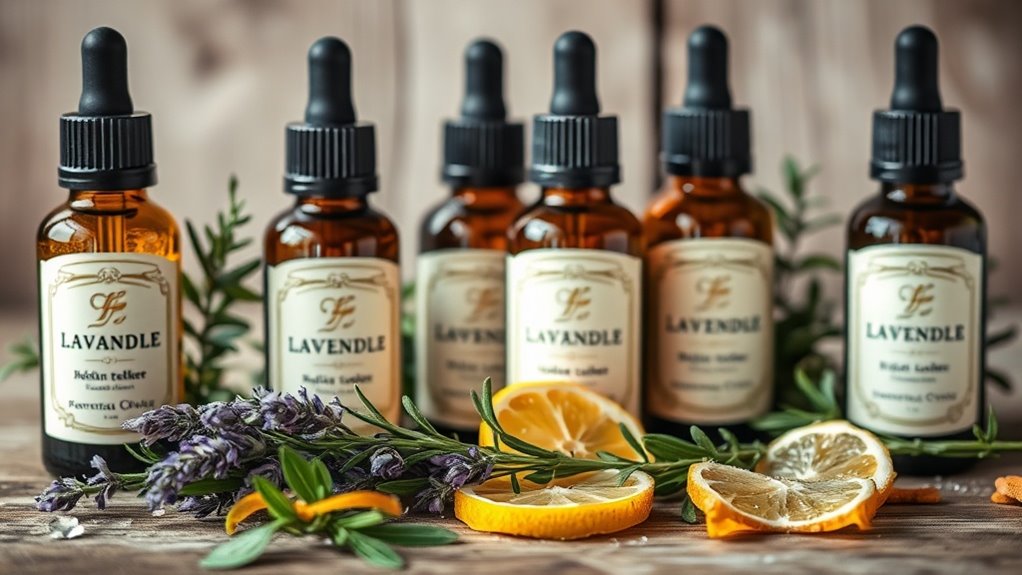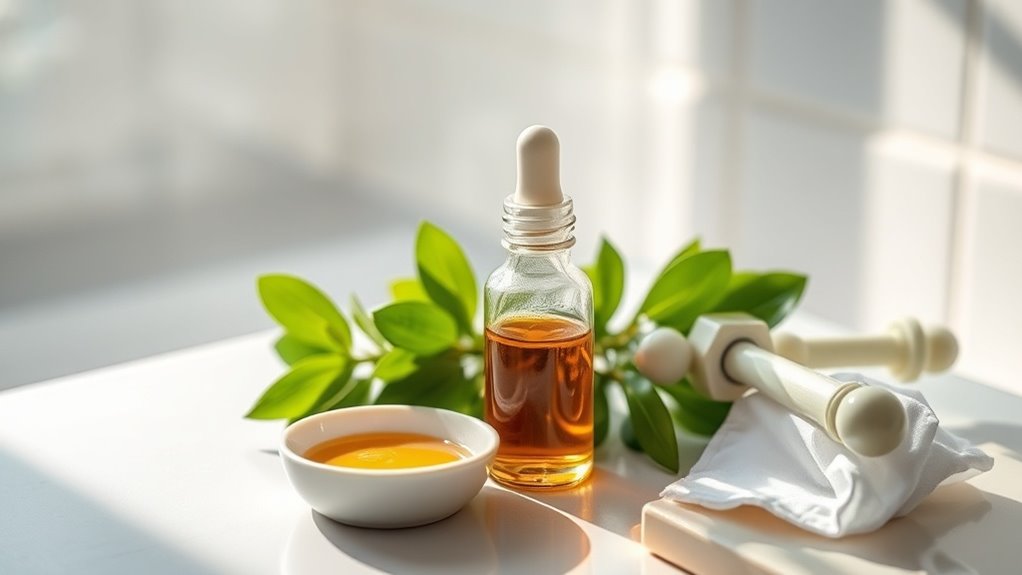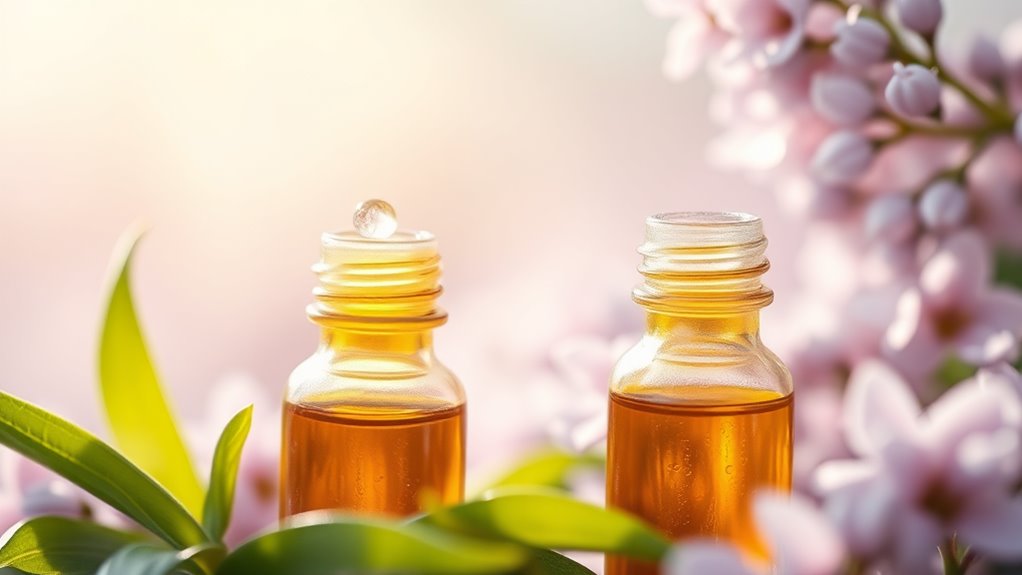These Essential Oils Are My Secret Weapon for Clear Skin
You’ve got essential oils like tea tree, lavender, and frankincense as your secret weapons for clear skin. Tea tree oil’s antibacterial properties fight acne-causing bacteria, reducing lesions by up to 40% per studies, while lavender soothes inflammation and frankincense boosts cell regeneration for smoother texture. It’s all about safe, diluted application for real results. Stick around to uncover more tips on blending these into your routine.
Top Essential Oils for Clear Skin
Have you ever wondered which essential oils can transform your skincare routine for clearer skin?
Lavender provides evidence-based antibacterial action to combat acne, as studies confirm its anti-inflammatory effects.
Frankincense promotes cell regeneration for smoother texture, supported by clinical research.
Eucalyptus offers purifying properties to unclog pores.
In addition to these, tea tree oil is renowned for its antimicrobial properties that effectively address various skin imperfections.
Use these essential oils diluted in your regimen for safe, noticeable results.
Benefits of Tea Tree Oil
Tea Tree Oil stands out as a key player in your skincare arsenal, delivering potent antibacterial and anti-inflammatory benefits that combat acne and promote clearer skin. Research confirms it targets acne-causing bacteria like Propionibacterium acnes, reducing lesions by up to 40%. You’ll experience less redness, faster healing, and balanced oil production, making it a reliable, natural option for maintaining healthy, blemish-free skin. Additionally, its essential oil properties can help soothe irritated skin and enhance overall complexion.
Lavender Oil Application Methods
You apply lavender oil topically to target blemishes and soothe inflammation, as studies confirm its effectiveness for clear skin. Always dilute it with a carrier oil like jojoba to avoid irritation, ensuring safe concentrations based on expert guidelines. This method lets you integrate lavender into your routine effectively for best results. Additionally, lavender oil is known for its antimicrobial properties, which can help prevent future breakouts.
Topical Use
Lavender oil’s topical application methods provide a simple, effective way to target skin imperfections.
You’ll apply it directly to blemishes using a cotton swab or gentle massage for fast results.
Evidence from dermatological studies highlights its antibacterial and anti-inflammatory properties, helping you reduce acne and soothe irritation without unnecessary complications.
Always prioritize clean tools for ideal skin health.
Dilution Techniques
Effective dilution techniques are essential for safely applying essential oils, minimizing risks like irritation or allergic reactions.
When using lavender oil, you’ll dilute it with a carrier oil like jojoba or coconut at a 2% ratio—about 12 drops per ounce—to prevent sensitivity, as studies confirm.
This evidence-based approach maximizes its antibacterial benefits for your clear skin routine, ensuring safe efficacy.
Frankincense for Skin Health
You benefit from frankincense’s anti-inflammatory properties, which reduce acne and promote clearer skin based on studies showing its efficacy. When you apply it, dilute a few drops in a carrier oil and gently massage it into your face for maximum absorption. This method supports skin repair by boosting cell regeneration, helping you achieve a healthier complexion. Additionally, frankincense has been shown to enhance skin health by improving skin tone and elasticity.
Frankincense Benefits
Frankincense, derived from the Boswellia tree’s resin, delivers powerful benefits for skin health.
You’ll find it reduces inflammation, easing acne and redness through its anti-inflammatory compounds.
Its antioxidants combat free radicals, preventing premature aging and supporting cell repair.
Evidence from studies shows frankincense enhances skin barrier function, promoting resilience and a clearer complexion.
Application Methods
The proper application of frankincense oil guarantees you maximize its skin health benefits.
You’ll always dilute it with a carrier oil like jojoba to avoid irritation—aim for a 2-5% concentration.
Apply a few drops to cleansed skin, massaging gently in circular motions.
Use twice daily for consistency.
Evidence from essential oil studies confirms this method promotes safe, effective absorption.
Always patch test first.
Skin Repair Effects
Frankincense oil actively supports skin repair by targeting inflammation and accelerating wound healing, drawing on compounds like boswellic acids that research has shown to minimize scars and boost collagen production.
You’ll notice quicker recovery from breakouts when you apply it diluted, as studies confirm its antioxidants protect against damage, helping you maintain even-toned, resilient skin for lasting clarity.
Incorporating Oils Into Daily Routines
Integrating essential oils into your daily routine can enhance your skin’s clarity with minimal effort.
You can blend them into your moisturizer or use them in a facial steam, as studies confirm their anti-inflammatory benefits.
Apply a diluted drop each morning and evening for consistency, always patch testing first.
Experts recommend this approach for sustained, evidence-based skin improvement, yielding noticeable results over time. Additionally, certain essential oils can provide natural alternatives to conventional skincare products, making them a versatile choice for many skin types.
Peppermint Oil for Blemish Control
Peppermint oil effectively tackles blemishes with its cooling menthol properties, which research links to reduced inflammation and bacterial growth.
You’ll experience quick relief as it soothes irritated skin and curbs acne.
Dilute it in a carrier oil like jojoba before applying, as studies confirm its antimicrobial action minimizes breakouts and enhances your skin’s natural clarity.





